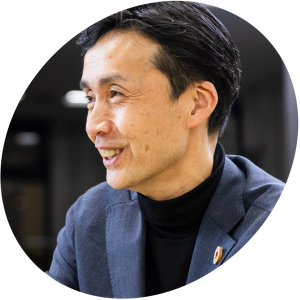行政だけでなく企業や団体、市民を招き入れながら、一緒にイノベーションを起こしていく——一貫してそうした取り組みを続けてきた、渋谷未来デザインのFuture Designerのひとり、野村恭彦さん。
あらためてこれまでの活動を振り返っていただくと、そこに通底する信念、野村さんが理想的だと感じる市民共創やシティプライドのあり方が、みえてきました。

市民が自分たちで意思決定していけるまち
——まずはあらためて、野村さんのこれまでの活動についておしえてください
私はずっと富士ゼロックスという会社で、イノベーションや知識創造型組織をどうつくっていくかということの研究やコンサルティングを長くやっていたのですが、東日本大震災を契機にフューチャーセッションズという会社を原宿で起業しました。それまでは企業から起こすイノベーションというものに注力していたわけですが、震災からの復興にあたって、地域と企業とNPOのコラボレーションによってゼロから新たなイノベーションを生み出すことができるということに可能性を感じ、いろいろなプロジェクトに取り組んできました。
そうしたなかで、渋谷区においても、行政と企業とNPOをまたぐクロスセクターの取り組みをつくりたいと考え、長谷部渋谷区長や澤田副区長と協力しながら、「渋谷をつなげる30人」というプロジェクトを立ち上げました。
行政がクライアントのプロジェクトとなると、どうしても特定の企業との限定された関係の中で進められてしまいがちですが、「渋谷をつなげる30人」は、渋谷区の未来をつくるようなマインドを持った人が、あらゆる企業、あらゆるNPOにいるという状態をつくり、この人たちをひとつのコミュニティにして、イノベーションのプラットホームにしようというアイデアです。そこには行政の方も一員として入ってもらい、企業やNPO、行政の職員が一緒になって考えたアイデアをどうやって行政政策の中に活かしていくかということを検討していただいています。

そこから実現した具体的な施策のひとつに、落書き消しのプロジェクト「CLEAN&ART」があります。BEAMSさんやBOSCHさんといった企業が加わりながら、渋谷のまちに描かれてしまった落書きを、かっこよく楽しく消すという仕組みができあがりました。今では、落書きをされてしまった際に「CLEAN&ART」に頼むと、かっこよくBEAMSのユニフォームを着た人たちがボランティアでやってきて一生懸命落書きを消してくれて、その費用は渋谷区の予算からまかなわれるという制度になっています。
ただ、そういった成果が一番大事というよりも、そこに至るまでに企業の人とNPOの人、行政の人が協力し合って、自分たちでやろうと思ったことが、渋谷というまちのなかで実現していくという経験をしてもらうことこそが大事だと考えています。「渋谷をつなげる30人」プロジェクトが現在では7年目を迎え、メンバーは毎年入れ替わっていきますから、そうした経験を持つ人たちが渋谷のいろんな組織のなかにおよそ200人もいるわけです。そういう人たちが協力し合っていろんな課題解決ができるというイノベーションエコシステムのようなものをみんなで一緒につくってきました。
最終的に私自身が見たい景色というのは、市民協働でほとんどの政策が行われている状態——つまり、市民が本当の主権を持ったまちなのだと思っています。
渋谷未来デザインにおいてもその思いは変わりません。渋谷民を含めた多くの人たちがクロスセクターで関わって、渋谷の未来を自分たちでつくっていけるまちになるように、市民がまちづくりに参加し続ける仕組みをつくっていくのが、私自身の取り組みだと考えています。

渋谷民の知恵を集めて社会課題を超えていけたら
渋谷未来デザインのFuture Designerとして、プロジェクトに対していろんなかたちでアドバイスをしていくことが私たちの主な役割だと思いますが、同時に、定期的に行われる「Future Designer 会議」にはとても大きな魅力を感じています。
行政の施策というのは、多くのものが縦割のなかで進んでいきます。例えばIT部門が専門的にIT化について取り組み、一方で例えば障害者支援は障害者支援の部門がしっかりやる。でもFuture Designerの議論は、ここを完全に横串で見ていけるというのが一番面白いところです。解決するのが難しい社会課題を、どうやって横串の視点で解決するか。こっちの課題に対してあっちのリソースを持ってきたら…というような議論が、本当に縦横無尽に行われているんです。
長谷部区長が考えている政策を長谷部さん自身が語って、それに対してみんながこんなことができるんじゃないか、あんなことができるんじゃないかと本気で議論している。それは自分たちの利益などは全く関係なく、みんな本当に渋谷のためにという思いで議論しているんですよね。
そしてそれを、渋谷未来デザインに参画する企業の人たちが聞いているわけです。そうすると今度は企業もアイデアを出していくことができる。こんな都市戦略みたいなことをオープンな場で話し合うことは、とても素敵だと思います。
このまちをどうしていくのか、この社会課題をどう超えていくのか、というようなことを、渋谷民の知恵を結集して考えて、その実現の仕方もクリエイティブに、いろんな立場の人がいろんな提案をしていく。こういう議論が、企業間でも、市民の間でも増えてきて、まち全体としての意思決定に影響してくるようになっていったら素晴らしいなと思っています。

観光を通して再認識する地域の魅力と、市民の誇り
—— 一方で、渋谷という文脈を離れてそれぞれの専門分野で活躍されて、その経験をまた渋谷へ還元していくというところも、Future Designerが期待されていることのひとつだと思います。野村さんの、今現在から未来に向けての取り組みについてもおしえてください。
私は今、ツーリズムを使って地域を良くしていくということをやろうとしています。
たとえば、奄美群島の喜界島というところで実現したいと思っていたことに「プラスチックフリージャーニー」というものがありました。これは、旅をしている間、使い捨てプラスチックに触れないで過ごすというのがコンセプト。海外からプラスチックフリーの人たちが観光に来るなら、地域の方々は、なんとかプラスチック無しで彼らを迎えようというホスピタリティを持つわけです。それがやってみたら意外とできるということになれば、「そもそも日頃からプラスチックを使う必要あったんだっけ」という考え方になっていけるんですよね。
観光の力をうまく使って、地域の本当に残したいものや、あるいは地域が本当にもっとよくしたいものを、みんなで取り戻していくような旅のエクスペリエンスをつくりたいんです。海の美しい喜界島のような場所の場合は、プラスチックフリーのコンセプトと親和性が高いわけです。
では渋谷の場合ならどうなるか。渋谷や東京はやはり産業のインフラを支えているまちなので、なんとなく持続可能性というものが消費者マインドと強くつながっている部分があると思います。ですから渋谷の中に、自分たちの持続可能性を自分たちでつくっていくというムーブメントを起こしてみたいですし、渋谷に観光に来る人、遊びに来る人はとても多いので、彼らにどうやって渋谷の持続可能性というものに対する感度を高める体験をしてもらえるか——ツーリズムの力を使って持続可能な都市・渋谷というものを考える経験をしてもらうための取り組みというのはやってみたいですね。

地域の人たちがホスピタリティの気持ちをもって、そのまちの特性や魅力に沿った体験を観光客に提供すると同時に、観光客の側から地域の良さを再確認させてもらうことで、それが自分自身の信念になるというステップが踏めると、自分はこのまちでこういうことをしているということが自身の誇りになっていくと思うんです。
日本はこれまで生産性中心でずっとやってきましたけど、大袈裟にいえば、生産的でなければいる価値がないとも思えてしまうような価値観、つまり「ウェルビーイング」じゃなくて「ウェルドゥーイング」の価値観で社会がずっとつくられてきたのだと思います。キャピタリズムをベースにした、「活躍する人に価値がある」という考え方が普及してしまって、たとえば高齢者の多くが「迷惑をかけたくない」と思いながら生きているというようなことが起きています。けれどもやはり、自分がこのまちで生きてることが、もうそれだけで価値なんだという社会にしていきたいですよね。
特に渋谷という場所はまさに「ちがいをちからに変える街」ですから、パフォーマンスが高いから価値があるのではなくて、自分がそこにいること自体に価値があるんだということを感じさせてくれるような、そういう自己肯定感を高めるまちになってほしいと思っています。
文)天田 輔
写真)寺林 紘喜
渋谷未来デザイン Future Designer の記事
▶︎ 佐藤夏生さん『まだない未来をつくるだけでなく、何を未来に残すかも大切』
▶︎ 関治之さん『テクノロジーが、社会を良くする方向へ使われるように』
▶︎ 林千晶さん『自分が本当に生きたい未来に、とことん向き合う』
▶︎ 齋藤精一さん『解像度の高い渋谷の街、データ活用で課題解決のパズルを合わせる』
▶︎ 若槻千夏さん×長谷部渋谷区長『地域みんなで子どもを育てられる渋谷区に』



